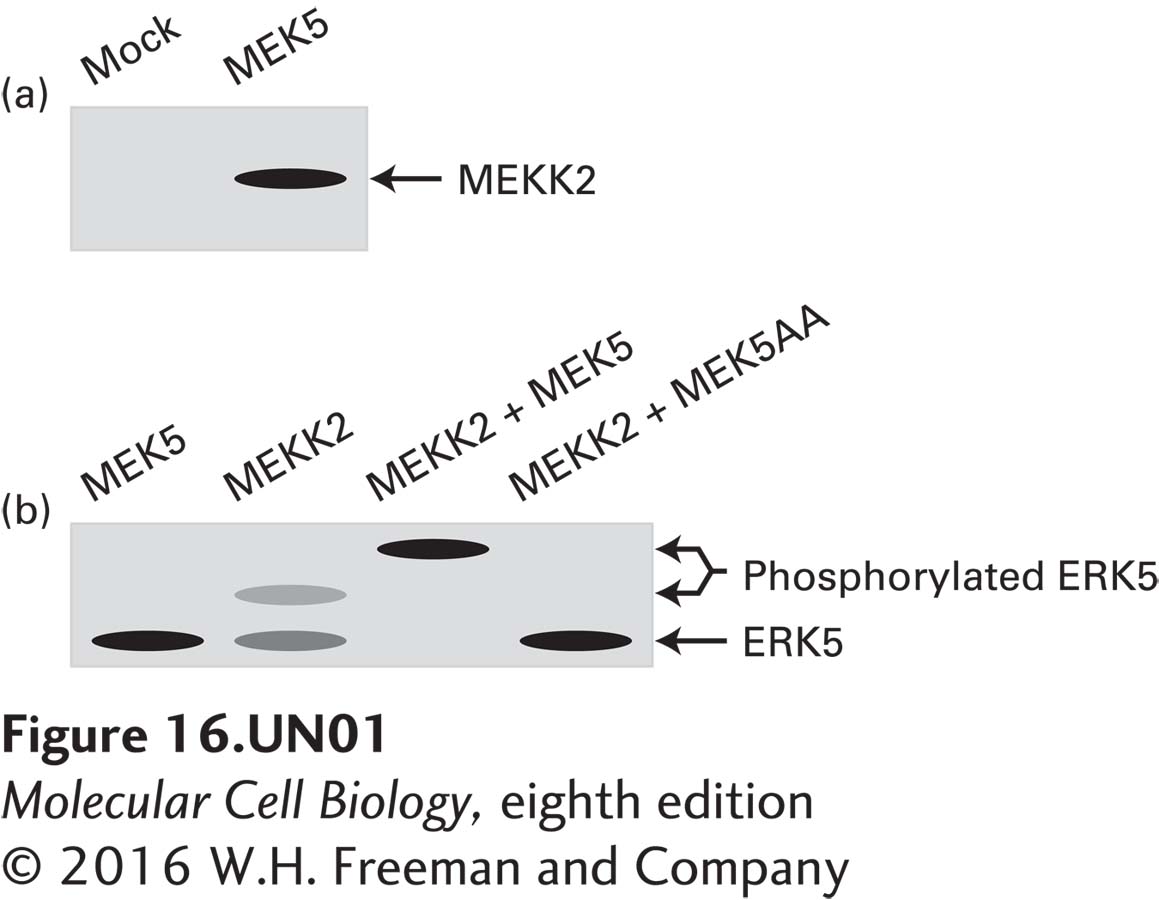
Chapter 16. Identifying the MAP Kinase Signaling Pathway Components
Introduction

Analyze the Data 16-1: Identifying the MAP Kinase Signaling Pathway Components
G. Johnson and colleagues have analyzed the MAP kinase cascade in which the MEK kinase MEKK2 participates in mammalian cells. By a yeast two-hybrid screen (see Chapter 9), MEKK2 was found to bind MEK5, which can phosphorylate a MAP kinase. To elucidate the signaling pathway transduced by MEKK2 in vivo, the following studies were performed in human embryonic kidney (HEK293) cells in culture.
a. HEK293 cells were transfected with a plasmid encoding recombinant, tagged MEKK2, along with a plasmid encoding MEK5 or a control vector that did not encode a protein (mock). Recombinant MEK5 was precipitated from the cell extract by absorption to a specific antibody. The immunoprecipitated material was then resolved by polyacrylamide gel electrophoresis, transferred to a membrane, and examined by Western blotting with an antibody that recognized tagged MEKK2. The results are shown in part (a) of the figure below. What information about this MAP kinase cascade do we learn from this experiment? Do the data in part (a) of the figure prove that MEKK2 activates MEK5, or vice versa?

This experiment reveals that MEK5 and MEKK2 co-localize within a complex because immunoprecipitation with a MEK5 antibody also precipitates MEKK2. However, these data give no evidence as to whether MEKK2 activates MEK5 or MEK5 activates MEKK2.
b. ERK5 is a MAP kinase previously shown to be activated when phosphorylated by MEK5. When ERK5 is phosphorylated by MEK5, its migration on a polyacrylamide gel is retarded. In another experiment, HEK293 cells were transfected with a plasmid encoding ERK5 along with plasmids encoding MEK5, MEKK2, MEKK2 and MEK5, or MEKK2 and MEK5AA. MEK5AA is a mutant, inactive version of MEK5 that functions as a dominant-negative. Expression of MEK5AA in HEK293 cells prevents signaling through active, endogenous MEK5. Lysates of transfected cells were analyzed by Western blotting with an antibody against recombinant ERK5. From the data in part (b) of the figure, what can we conclude about the role of MEKK2 in the activation of ERK5? How do the data obtained when cells are cotransfected with ERK5, MEKK2, and MEK5AA help to elucidate the order of participants in this kinase cascade?
MEKK2 is required for the activation of ERK. However, MEKK2 cannot activate ERK unless MEK5 is present. MEKK2 alone partially activates ERK5 because there is some endogenous MEK5, but in the presence of MEK5AA, which inhibits endogenous MEK5, MEKK2 cannot activate ERK5. These experiments clearly place ERK5 downstream of MEKK2 and MEK5 in the signaling pathway; however, they do not unambiguously order MEKK2 and MEK5. To do so would require co-expression of ERK5, MEK5AA, and a constitutively active form of MEKK2. If ERK5 were phosphorylated, then MEKK2 would be downstream of MEK5. If not, then MEKK2 would be upstream of MEK5.
Activity results are being submitted...